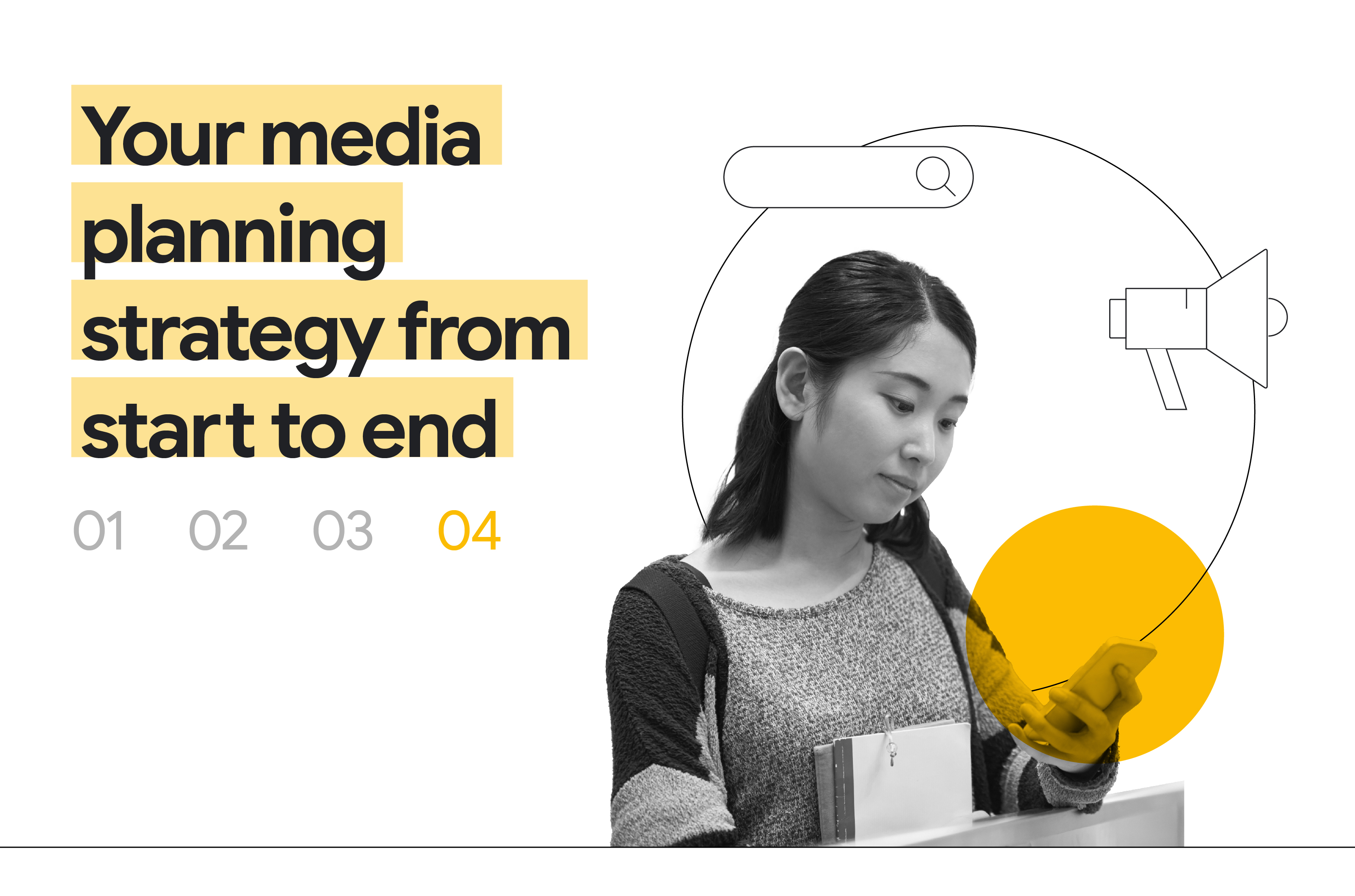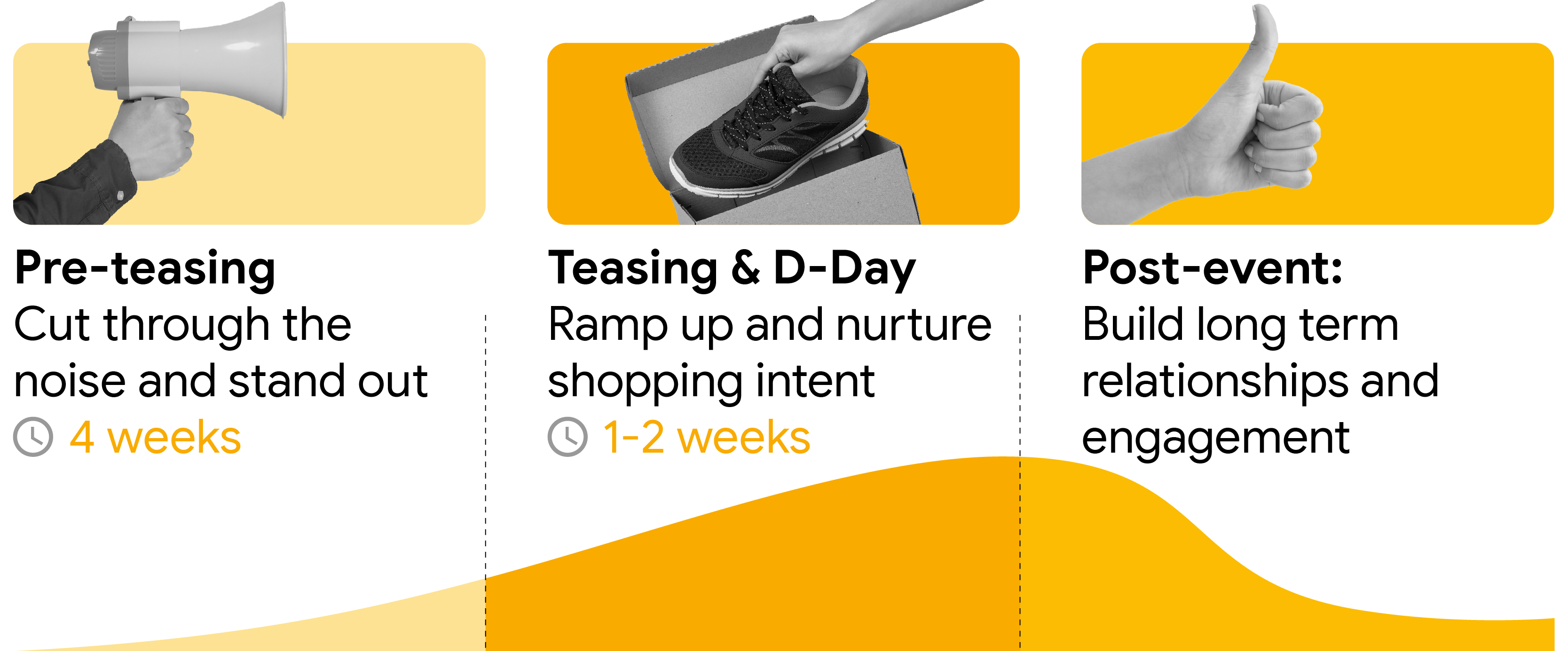
In the last of our four-part guide, we share a media planning strategy that covers every phase of a mega sale event. Read the previous sections of the guide to learn about the latest shopper trends, creative best practices, and ways to create seamless shopping experiences.
In the minds of consumers, mega sale events don’t actually kick off on their scheduled sale days. Shoppers start preparing for them way in advance and continue to look out for deals after the events. That’s why it’s critical for your brand to have a comprehensive media strategy that spans the entire mega sale event cycle — from well before it starts to the immediate lead-up and the sale itself and after the event officially ends.
With an end-to-end mega sale media strategy in place, you’ll be able to get the most out of your attention-grabbing creative and seamless shopping experiences. Here, we share media planning and measurement strategies for each phase of a mega sale event, along with tips on building brand awareness, ramping up a sale campaign, and maintaining relationships with customers.

Pre-teasing phase: Cut through the noise and stand out
The pre-teasing phase of a mega sale event is all about winning your customers’ attention. It typically commences early, with shoppers starting their search as early as four weeks before a double-digit event day.1 One reason they search in advance: brands offer sneak peeks of upcoming discounts and early-bird vouchers.
In this phase, while people browse for deals, brands have an opportunity to inspire and influence purchase decisions by being present and standing out. A full-funnel marketing strategy that includes upper-funnel marketing through video ad campaigns, for example, can help.
Online video is an important channel for brands in this phase because it’s a major source of discovery for shoppers. Sixty-three percent of shoppers in Singapore often watch video reviews or product recommendations first before shopping online during shopping festivals,2 and over 85% of YouTube shoppers in Indonesia, Thailand, Vietnam, and the Philippines agree that YouTube enhances the traditional shopping journey by delivering unexpected inspiration.3
Video reach campaigns, for example, can help brands find their key audiences while providing cost efficiencies. To measure the success of these video campaigns, a Brand Lift study can analyse the uplift in awareness or ad recall.

Another upper-funnel marketing strategy is to capture search interest when people are browsing online. With search engines being one of the top touchpoints for shopping inspiration and discovery during shopping and holiday sale events in APAC,4 solutions such as broad match can help take your Search campaigns to a new level.
Broad match keywords enable you to reach more audiences because it connects your brand to people with related searches, not just those whose searches contain your exact keywords. It works best when combined with Smart Bidding, which optimises bids based on your budget and goals.
It’s also helpful, in this phase, to attract attention with products that are likely to be popular. You can find out what’s currently trending by using the best sellers report and demand forecasts, and showcase related products in your sale and on your website.
Teasing phase and D-Day: Ramp up and nurture shopping intent
One to two weeks before a mega sale event is the teasing phase when people compare products before deciding what they’ll buy on the sale day itself. To make the most of this phase when excitement around the sale is building, you should ramp things up to reach and convert high-intent shoppers.

For a start, you can use Performance Planner to understand seasonal marketing opportunities and plan your advertising budget. This solution helps you monitor how adjusting campaign spend will affect conversion metrics used in your Google Ads performance reports.
Pro tip: Before the big day, shoppers are likely to add products to their carts but not check out, so lower your target return on ad spend to reach more customers during this teasing period.
In this phase, when consumers explore and evaluate products across multiple platforms, from websites and apps to e-commerce sites and physical stores, your brand can use Google’s automated solutions to reach high-intent shoppers, wherever they are researching or shopping, and automatically maximise seasonal sale opportunities.
Performance Max, for example, enables you to connect with your desired audience via a single automated campaign that shows up across Google’s full suite of ad channels such as YouTube, Search and Gmail. In some countries,5 it even enables you to promote your store locations to people browsing on Google Maps, Search, YouTube, and the Display Network and direct them to your store to make their purchase.
If you’re looking to connect with those who prefer shopping in an app during a mega sale, App campaigns can help you promote your app across platforms to bring in new users or re-engage existing ones.
As for driving conversions on e-commerce sites such as Shopee, your brand can tap into Retail Partnerships with Google Ads. This solution enables you to drive high-intent shoppers to your store on your retail partner’s platform.
Post-event phase: Build long-term relationships and engagement
The shopping momentum might dip after a mega sale event, but your relationship with customers shouldn’t enter a lull because peak shopping moments increasingly occur throughout the year, and nurturing year-long relationships with customers will help your brand stay top of mind.
To engage shoppers all year long and get them excited about your products and services, having an always-on sales campaign in your media strategy can help. It enables your brand to show up when people are searching for mega sale events, which tends to be from one sale to another without delay. In Indonesia, for instance, search interest in “12.12 sale” and “Black Friday sale” started to climb even as search interest in “11.11 sale” just peaked.6

By showing up at all phases of a mega sale cycle and maintaining an ongoing relationship with customers, you’re more likely to be top of mind when they are ready to purchase. For more tips on retail strategies to connect with customers on their shopping journey, check out our latest Retail Guide, and explore the rest of our mega sale guide to find out what shoppers prioritise, how to build the best ad creative, and how to create seamless shopping experiences.
Contributor: Rachael Powell, APAC Consumer and Market Insights Lead








